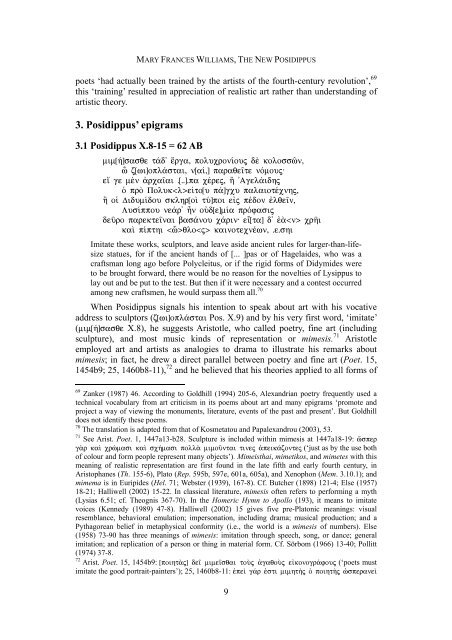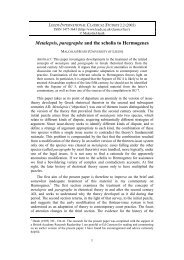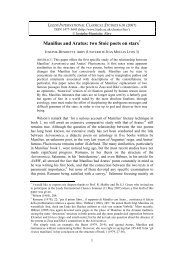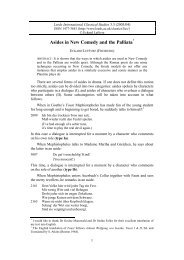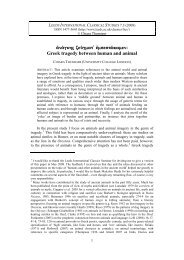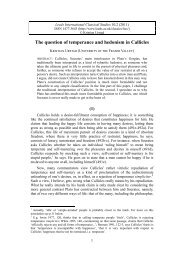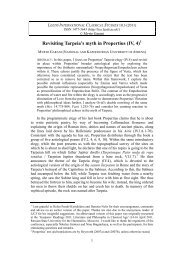The New Posidippus - Leeds International Classical Studies
The New Posidippus - Leeds International Classical Studies
The New Posidippus - Leeds International Classical Studies
You also want an ePaper? Increase the reach of your titles
YUMPU automatically turns print PDFs into web optimized ePapers that Google loves.
MARY FRANCES WILLIAMS, THE NEW POSIDIPPUS<br />
poets ‘had actually been trained by the artists of the fourth-century revolution’, 69<br />
this ‘training’ resulted in appreciation of realistic art rather than understanding of<br />
artistic theory.<br />
3. <strong>Posidippus</strong>’ epigrams<br />
3.1 <strong>Posidippus</strong> X.8-15 = 62 AB<br />
mim[»]sasqe t£d' œrga, polucron…ouj d kolossîn,<br />
ð z[wi]opl£stai, n[a…,] paraqe‹te nÒmouj:<br />
e‡ ge m n ¢rca‹ai .[..].pa cšrej, À 'Agel£idhj<br />
Ð prÕ Poluke…to[u p£]gcu palaiotšcnhj,<br />
À oƒ Didum…dou sklhr[oˆ tÚ]poi e„j pšdon lqe‹n,<br />
Lus…ppou ne£r' Ãn oÙd[e]m…a prÒfasij<br />
deàro parekte‹nai bas£nou c£rin: e [ta] d' ¦ crÁi<br />
kaˆ p…pthi qlo kainotecnšwn, .e.shi<br />
Imitate these works, sculptors, and leave aside ancient rules for larger-than-lifesize<br />
statues, for if the ancient hands of [... ]pas or of Hagelaides, who was a<br />
craftsman long ago before Polycleitus, or if the rigid forms of Didymides were<br />
to be brought forward, there would be no reason for the novelties of Lysippus to<br />
lay out and be put to the test. But then if it were necessary and a contest occurred<br />
among new craftsmen, he would surpass them all. 70<br />
When <strong>Posidippus</strong> signals his intention to speak about art with his vocative<br />
address to sculptors (z[wi]opl£stai Pos. X.9) and by his very first word, ‘imitate’<br />
(mim[»]sasqe X.8), he suggests Aristotle, who called poetry, fine art (including<br />
sculpture), and most music kinds of representation or mimesis. 71 Aristotle<br />
employed art and artists as analogies to drama to illustrate his remarks about<br />
mimesis; in fact, he drew a direct parallel between poetry and fine art (Poet. 15,<br />
1454b9; 25, 1460b8-11), 72 and he believed that his theories applied to all forms of<br />
69 Zanker (1987) 46. According to Goldhill (1994) 205-6, Alexandrian poetry frequently used a<br />
technical vocabulary from art criticism in its poems about art and many epigrams ‘promote and<br />
project a way of viewing the monuments, literature, events of the past and present’. But Goldhill<br />
does not identify these poems.<br />
70 <strong>The</strong> translation is adapted from that of Kosmetatou and Papalexandrou (2003), 53.<br />
71 See Arist. Poet. 1, 1447a13-b28. Sculpture is included within mimesis at 1447a18-19: ésper<br />
g¦r kaˆ crèmasi kaˆ sc»masi poll¦ mimoàntai tinej ¢peik£zontej (‘just as by the use both<br />
of colour and form people represent many objects’). Mimeisthai, mimetikos, and mimetes with this<br />
meaning of realistic representation are first found in the late fifth and early fourth century, in<br />
Aristophanes (Th. 155-6), Plato (Rep. 595b, 597e, 601a, 605a), and Xenophon (Mem. 3.10.1); and<br />
mimema is in Euripides (Hel. 71; Webster (1939), 167-8). Cf. Butcher (1898) 121-4; Else (1957)<br />
18-21; Halliwell (2002) 15-22. In classical literature, mimesis often refers to performing a myth<br />
(Lysias 6.51; cf. <strong>The</strong>ognis 367-70). In the Homeric Hymn to Apollo (193), it means to imitate<br />
voices (Kennedy (1989) 47-8). Halliwell (2002) 15 gives five pre-Platonic meanings: visual<br />
resemblance, behavioral emulation; impersonation, including drama; musical production; and a<br />
Pythagorean belief in metaphysical conformity (i.e., the world is a mimesis of numbers). Else<br />
(1958) 73-90 has three meanings of mimesis: imitation through speech, song, or dance; general<br />
imitation; and replication of a person or thing in material form. Cf. Sörbom (1966) 13-40; Pollitt<br />
(1974) 37-8.<br />
72 Arist. Poet. 15, 1454b9: [poiht¦j] de‹ mime‹sqai toÝj ¢gaqoÝj e„konogr£fouj (‘poets must<br />
imitate the good portrait-painters’); 25, 1460b8-11: peˆ g£r sti mimht¾j Ð poiht¾j æsperaneˆ<br />
9


